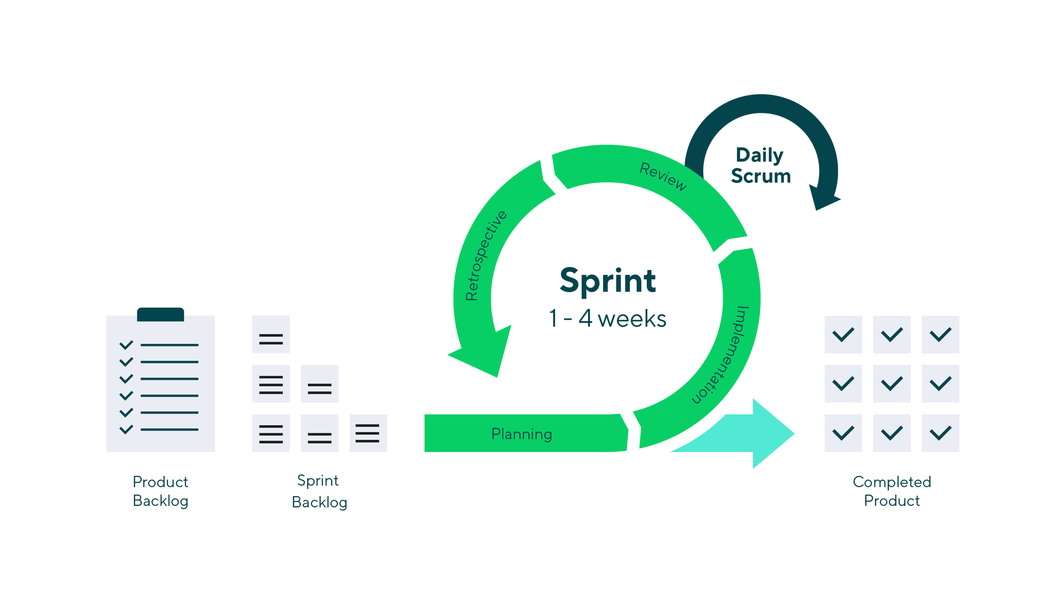What is a Scrum sprint? How long should a Scrum sprint last? What’s the best way to plan a Scrum cycle? Every Scrum team is different, but the one thing that unites them is the need to execute effective and successful sprints.
In this Scrum guide, we’ll conduct a deep dive into the world of Agile software development. We’ll explore the various components of the Scrum framework, including sprint planning, sprint ceremonies, and what happens after the sprint is completed. Let’s begin with the definition of a Scrum sprint.
What is a Scrum sprint?
A Scrum sprint is a time-boxed iteration period during an ongoing development cycle where a specific set of features or capabilities are worked on. A sprint usually runs for one to four weeks. During that time, the Scrum team’s main goal is to provide a product increment — a version of the product that includes the features and backlog items prioritized and completed during the sprint.
Think of a sprint as a way of breaking down the project into bite-sized chunks. In each stage, what is worked on next is based on feedback and the features prioritized during the backlog grooming and sprint planning process.

How many sprints are in a Scrum project?
There is no defined or “ideal” number of sprints in a project. This is because sprints are dependent on the scope of your project. Longer projects will inevitably have more sprints, but if your project is 12 weeks long, four to six sprints may be an average/standard number of sprints. This brings us to the stages involved in the sprint process.
Stages of a Scrum sprint in project management
Within the Scrum framework, key stages such as planning, execution, the sprint review, and the sprint retrospective emerge. In this section, we’ll cover typical Scrum events and demonstrate how they affect the future state of the product.
Planning stage
To begin, the Scrum team holds a sprint planning meeting. Here, the product owner and the development team meet to decide what product backlog items are being prioritized for the next sprint. The development team will share key information regarding bandwidth and capacity. In the planning stage, a sprint goal is defined.
Implementation
This is the stage that involves the bulk of the effort of the development team. During this process, the team works to produce a product increment. While the product owner doesn’t typically participate in implementation, they should be available to answer any questions the Scrum team may have during the sprint process.
The team holds a daily Scrum meeting to keep up with progress and ensure every team member is on the same page with regards to accomplishing the sprint goal.
Sprint review and testing
At the end of every sprint, the Scrum team, product owner, Scrum master, and stakeholders gather together to hold a sprint review meeting to test whether the product increment holds up.
In this stage, the product owner confirms if the functionalities fit the sprint’s requirements and whether the team has accomplished the objective for the sprint.
Sprint retrospective
In this stage, the Scrum team, Scrum master, and product owner hold a sprint retrospective where they discuss the sprint process, identify what was a success, and outline what could be improved upon.
What to do before a Scrum sprint?
The Scrum sprint process can be challenging if it is not managed well. Let’s take a look at three necessary steps you can follow to make the sprint process a success:
Step 1: Create, maintain, and prioritize the backlog on an ongoing basis
The product owner is responsible for maintaining the product backlog. The goal is to ensure that essential product functionalities are given the highest priority. This also ensures there is no confusion about which features will be implemented during each Scrum sprint cycle.
Step 2: Consider the Scrum team’s capacity during the sprint planning phase
The Scrum team shouldn’t take on more than they can handle during each sprint. So, before defining the sprint goal and finalizing the sprint backlog, the Scrum team should be transparent about their capacity and take care not to overcommit.
Step 3: Apply Agile Scrum principles and values
Agile Scrum principles and values serve as important guidelines that ensure that the sprint produces the best possible product. Ideally, a Scrum master helps facilitate the proper execution of Agile Scrum principles and values. This empowers the team to self-organize successfully and navigate through challenges and changes. When the team applies the right Scrum values, they face fewer obstacles and work at their best capacity.
Importance of Scrum sprints
When Scrum sprints are managed and run successfully, they can be very beneficial and improve project outcomes. Here are some of the top benefits Agile Scrum teams gain from well-run sprints.
More transparency
At every stage of the sprint process, the Scrum team collaborates and shares ideas that could impact the project’s success. Team members are free to express any objections, keeping in mind the sprint length, goals, and objectives. This ensures that everyone remains on the same page and reduces the chances of project failure.
Increased productivity
The sprint process helps improve the productivity of the team and enables continuous improvement. One outcome of a successful sprint process is that the team is able to work on high-value, high-priority tasks and features.
Improved focus and clarity
Scrum sprints normally involve the breakdown of a project into smaller tasks and objectives. This ensures that the team can actually focus and collaborate to achieve the sprint goal at hand. That means the team isn’t focusing on a million different tasks and priorities.
Flexibility
Working in sprints enables the Agile Scrum team to adapt and respond to change based on evolving priorities and customer feedback. Agile project management requires a level of team flexibility. Sprints ensure that teams are not overly rigid or planning too far ahead to be able to respond to change.
Successful Scrum teams use Wrike
In Agile methodology, it’s essential that Scrum teams are able to collaborate effectively, prioritize work, and deliver quickly.
Project management software like Wrike gives teams visibility and enables them to plan and execute more collaborative sprints. Learn more about how Scrum teams work together to achieve sprint objectives in the Scrum Team Roles section of this guide.


